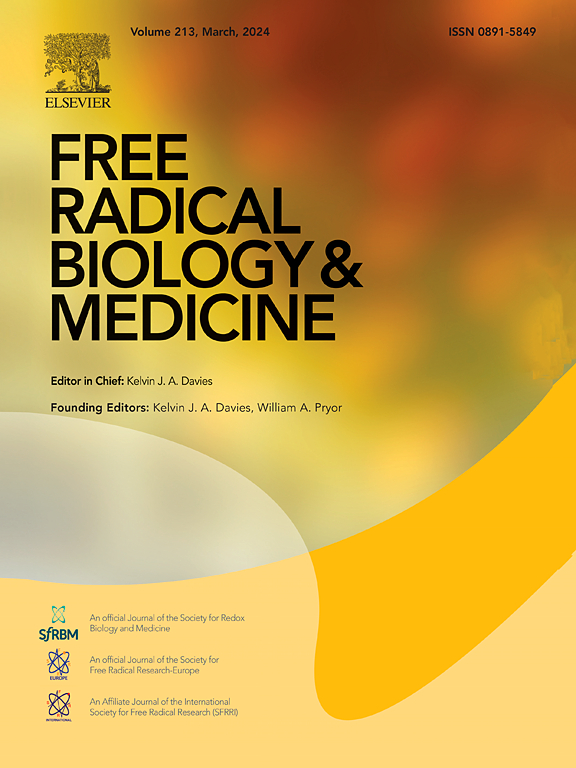氧化应激诱导的线粒体DNA (mtDNA)释放通过激活单核细胞中的cGAS-STING信号通路促进白癜风的进展
IF 7.1
2区 生物学
Q1 BIOCHEMISTRY & MOLECULAR BIOLOGY
引用次数: 0
摘要
白癜风是由细胞毒性CD8+ T细胞破坏黑素细胞引起的,最近发现白癜风与线粒体DNA (mtDNA)有关,线粒体DNA是一种已知可触发先天免疫的DAMP。然而,mtDNA在白癜风发病机制中的确切作用仍然知之甚少。在这项研究中,我们观察到白癜风患者血清和脱色病变中mtDNA水平显著升高。重要的是,我们发现氧化应激诱导角化细胞和血管内皮细胞产生mtDNA,为其系统性和局域积累提供了可能的来源。使用小鼠模型,我们证明了外源性mtDNA管理显着加速白癜风的进展,正如明显的尾部色素沉着所证明的那样。在机制上,mtDNA可以激活单核细胞中的cGAS-STING-IFN-α/β通路,导致CD8+ T细胞增加IFN-γ的产生,同时降低调节性CD4+ T细胞(Tregs)的频率和功能。与这些发现一致的是,白癜风小鼠mtDNA治疗导致IFN-γ+ CD8+ T细胞向受影响组织的浸润增加,同时Treg数量和活性显著降低,从而加剧了自身免疫反应。总的来说,这些发现强调了mtDNA-STING信号在白癜风进展中的关键作用,并强调了该途径作为治疗干预的有希望的靶点。我们的研究结果表明,mtDNA可能在白癜风和其他自身免疫性疾病的发病机制中起着重要的中介作用,为潜在的治疗靶点提供了新的见解。本文章由计算机程序翻译,如有差异,请以英文原文为准。

Oxidative stress-induced release of mitochondrial DNA (mtDNA) promotes the progression of vitiligo by activating the cGAS-STING signaling pathway in monocytes
Vitiligo, driven by cytotoxic CD8+ T cells destroying melanocytes, has recently been linked to mitochondrial DNA (mtDNA), a DAMP known to trigger innate immunity. However, the precise role of mtDNA in vitiligo pathogenesis remains poorly understood. In this study, we observed significantly elevated mtDNA levels in both the serum and depigmented lesions of vitiligo patients. Importantly, we found that oxidative stress induces mtDNA production in keratinocytes and vascular endothelial cells, providing a plausible source for its systemic and localized accumulation. Using the mouse odel, we demonstrated that exogenous mtDNA administration markedly accelerated progression of vitiligo, as evidenced by pronounced tail depigmentation. Mechanistically, mtDNA can activate the cGAS-STING-IFN-α/β pathway in monocytes, leading to an increased production of IFN-γ by CD8+ T cells while simultaneously reducing the frequency and functionality of regulatory CD4+ T cells (Tregs). Consistent with these findings, mtDNA treatment in vitiligo mice led to heightened infiltration of IFN-γ+ CD8+ T cells into affected tissues, accompanied by a significant decrease in Treg numbers and activity, thereby exacerbating the autoimmune response. Collectively, these findings underscore the pivotal role of mtDNA-STING signaling in vitiligo progression and highlight this pathway as a promising target for therapeutic intervention. Our findings suggest that mtDNA may serve as a crucial mediator in the pathogenesis of vitiligo and other autoimmune diseases, providing new insights into potential therapeutic targets.
求助全文
通过发布文献求助,成功后即可免费获取论文全文。
去求助
来源期刊

Free Radical Biology and Medicine
医学-内分泌学与代谢
CiteScore
14.00
自引率
4.10%
发文量
850
审稿时长
22 days
期刊介绍:
Free Radical Biology and Medicine is a leading journal in the field of redox biology, which is the study of the role of reactive oxygen species (ROS) and other oxidizing agents in biological systems. The journal serves as a premier forum for publishing innovative and groundbreaking research that explores the redox biology of health and disease, covering a wide range of topics and disciplines. Free Radical Biology and Medicine also commissions Special Issues that highlight recent advances in both basic and clinical research, with a particular emphasis on the mechanisms underlying altered metabolism and redox signaling. These Special Issues aim to provide a focused platform for the latest research in the field, fostering collaboration and knowledge exchange among researchers and clinicians.
 求助内容:
求助内容: 应助结果提醒方式:
应助结果提醒方式:


